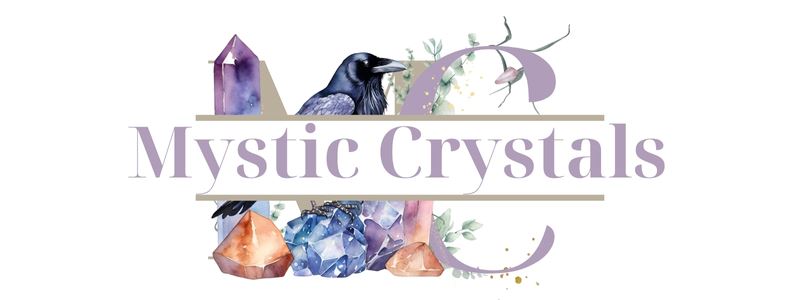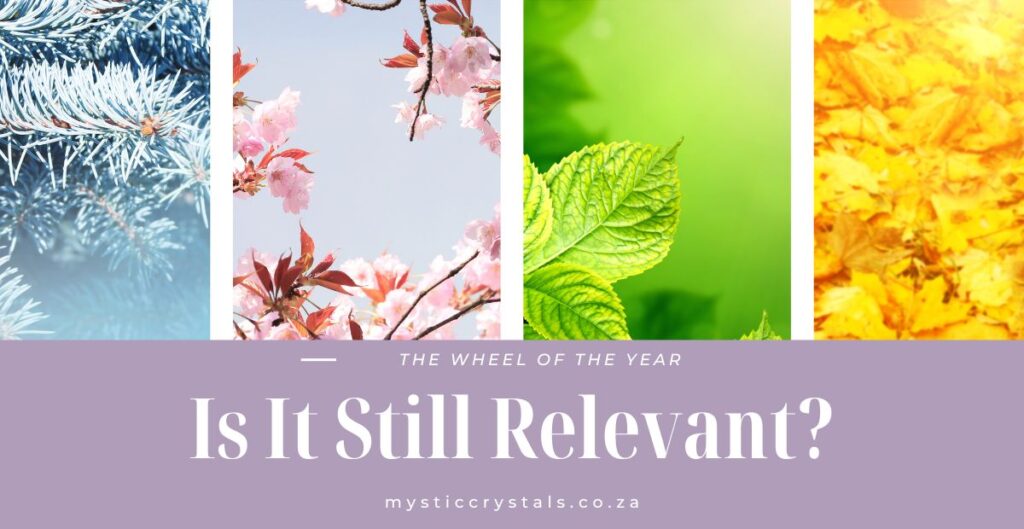What is the Wheel of the Year? Where does it come from? What are the pagan holy days or festivals? Read on to learn about the Wheel of the Year, the annual pagan calendar with its 8 special festivals.
Table of Contents
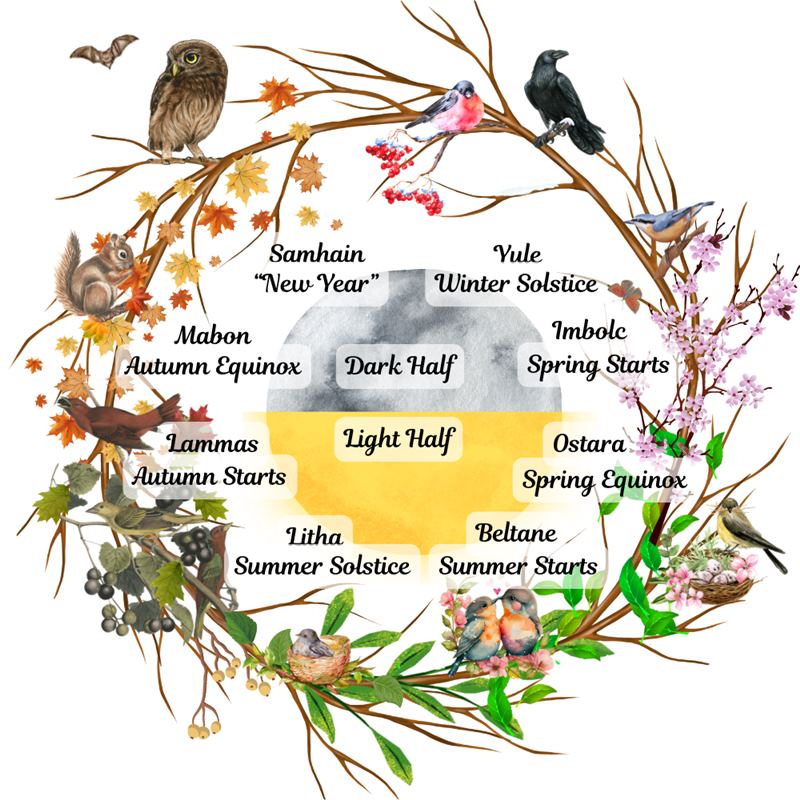
Introduction
The Wheel of the Year, or the Wheel of Life, represents the cycles of the Earth and life itself.
It is the Pagan calendar that describes eight sabbats, which are festivals that mark solar waypoints and seasonal changes throughout Earth’s cycle around the Sun. Together, these 8 holy days (holidays) form an annual calendar in the shape of a wheel.
It’s based on ancient Celtic, Norse and Germanic practices. It is how our ancestors marked the turning of the seasons and years, how farmers worked their land, and how we, as modern Pagans, reconnect to the rhythms of the natural world.
For more on why the Wheel of the Year is important to us in this day and age, read my article
The Wheel Symbology
The Wheel of the Year is delightfully full of rich, layered symbology. And you can really dive deep into exploring all the relationships and meanings that each turn represents.
There is the Light Half of the year (Spring and Summer) and the Dark Half (Autumn and Winter). There are solar festivals also known as Lesser Sabbats (the equinoxes and solstices), and seasonal festivals known as Grand Sabbats or Cross Quarter Days (the start of each of the four seasons, midway between each solar event).
Even the fact that the calendar is viewed as a circle is significant. It represents that while things change – living beings are born and pass away; there are good times and bad; the seasons are in perpetual motion – everything returns, in some way or another. Life is cyclical, everything goes round in a natural cycle.
The symbology and concepts in the Wheel of the Year, while based on Celtic and other proto-European cultures, are found in many ancient cultures throughout the world. There is a beautiful passage by Black Elk, a shaman of the Sioux Lakota people, of the power of circles which emphasises this:
“Everything the Power of the World does is done in a circle.
The sky is round, and I have heard that the earth is round like a ball, and so are the stars.
The wind, in its greatest power, whirls.
Birds make their nests in circles, for theirs is the same religion as ours.
The sun comes forth and goes down in a circle.
The moon does the same, and both are round.
Even the seasons form a great circle in their changing, and always come back again to where they were.
The life of a man is a circle from childhood to childhood,
and so it is in everything where power moves.” – Black Elk, 1862 – 1950
In this philosophy of perpetual motion there is the acceptance that change is inevitable, but at the same time, the deep comfort that nothing ever fully disappears. Many Pagans and ancient cultures believe in reincarnation or multiple lives in different forms or dimensions. In many Pagan religions, when someone dies, they return to Great Spirit and then may choose if they reincarnate (in human form or otherwise), return as a spirit guide, or travel somewhere beyond our knowing. Death is not the end, it is the beginning of a new cycle.
While most Pagan religions don’t believe in a “hell” realm where damned souls are sent for eternity, they instead see actions as seeds that grow as the Wheel turns. Like the saying “you reap what you sow” and “what goes around, comes around” – similar to the Hindu concept of karma. If you do not learn from the lessons presented to you by Life, those same lessons will keep repeating cyclically until you finally break the pattern by learning and growing beyond it.
Light And Dark
The Wheel of the Year is divided into two halves – the Dark half (cold, bleak autumn and winter) and the Light half (warm, fruitful spring and summer). Each half has two solar festivals and two seasonal festivals.
We mark this divide of Light and Dark at the equinoxes. The Dark half of the year starts at Mabon, the Autumn Equinox, and the Light half of the year starts at Ostara, the Spring Equinox. Symbolically, you can see Mabon as the annual sunset, and Ostara as the sunrise.

The Dark Half
Themes: Harvest, Withdrawal and Wisdom
The Dark half of the year is associated with Goddess and the Moon. It is a time of drawing inwards. In the cold, hibernating months we go within to do inner work, contemplation and meditation. We have time to rest and recuperate after the busy, bustling energy of the Light half of the year.
Our focus shifts to matters of the home and heart. We might mend worn clothing and make new things to wear, do arts and crafts projects, seed saving, etc.
The Light Half
Themes: Fertility, Expansion and Growth
The Light half of the year is associated with God and the Sun. This time of the year is about looking outwards. The sun is at full strength and life abounds everywhere you look.
We feel more social and outgoing, energised and active. It is a busy time full of weddings, feasts, harvests, births and preparing for the next winter.
In the Light Half of the year we work with our communities, traditionally planting the fields, tending the newborns, and gathering and preparing foods for the winter store. Births, weddings, harvest feasts and general merriment abound!
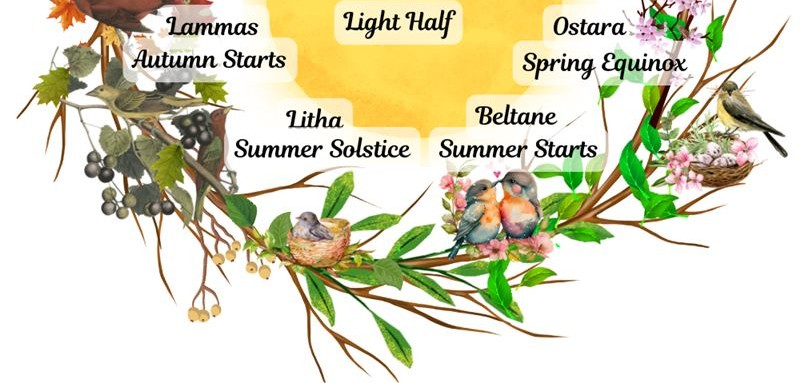
The Solar Festivals
Of the eight festivals, there are four solar festivals relating to the position of the Sun. They are traditionally dedicated to God as Father Sun, though different names and forms are used across different cultures and languages for each of the festivals. These four festivals are also called the Lesser Sabbats. They mark the two equinoxes and the two solstices we have each year.
The Sun appears to move away from us in the sky, then back towards us, each year in our journey around it. In the Southern hemisphere, it moves towards the North. In the Northern hemisphere, it is the opposite – the Sun moves away towards the South.
Read my article “Paganism North VS South” for the three key differences to practising Paganism in the Northern hemisphere VS practising in the Southern hemisphere.
In Summer, the Sun appears high in the sky and right above us at midday. Shadows are shorter, days are longer and we feel the sun’s rays very strongly!
Whereas in Winter, it appears lower in the sky, and more towards the North. We see long shadows, days are shorter, and even on a sunny winter’s day the sun’s rays are not quite as hot as in summer.
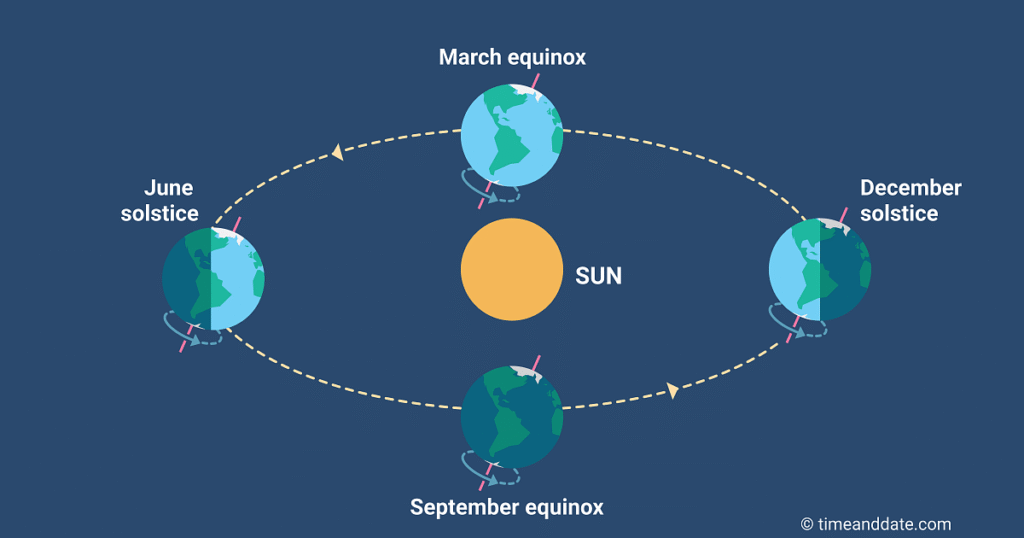
The Equinoxes
We mark the Wheel’s divide of Light and Dark at the equinoxes. The Dark half of the year starts at Mabon, the Autumn Equinox, and the Light half of the year starts at Ostara, the Spring Equinox.
Symbolically, you can see Mabon as sunset, and Ostara as sunrise.
An equinox is a point of balance in the year. The word ‘Equinox’ from the Latin ‘equi-’, meaning ‘equal’, and ‘nocti’-, meaning ‘night’. On this day, the sun faces directly over the equator, there are equal hours of light and dark, daylight and nighttime.
Equinox energy offers us the opportunity to look backwards and forwards in equal measure. Learning from the past, evaluating what may have worked or not worked, finding both strengths and weaknesses, and where opportunities may lie ahead. Then letting this wisdom guide our path forward.
Equinox energy is also a balancing of masculine and feminine energy – the Sun and Moon are equal, the Sun representing God and the Moon representing Goddess.
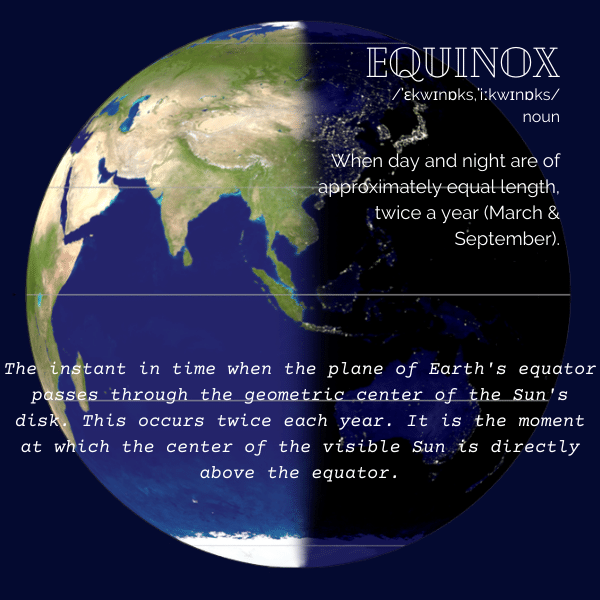
From a healing perspective, an equinox is a good time to work on bringing systems into equilibrium in both the energetic and physical body – mind, body and spirit.
The Solstices
The solstices are when we have the shortest day of the year (the fewest hours of daylight) and the longest (the most hours of daylight). It is the two furthest points the Sun “travels” to in the sky over the year.
When the Sun moves away from us in the sky, its rays are less warming, the hours of daylight fewer and fewer. Winter sets in across the land.
Until it reaches its farthest point away from us, and we have the day with the fewest hours of daylight- a point we call the Winter Solstice, Yule.
It then starts to return towards us, until it reaches its closest point to us. This is the Summer solstice, Litha, the day with the most hours of daylight.
The exact date varies each year by a margin of a few days. The earth rotates around the sun in 365.25 days, while our calendar is a set 365 days. We add a leap year every 4 years to the calendar to balance this out. So the precise date on the calendar that we celebrate these festivals depends on the year.
The word ‘solstice’ comes from the Latin ‘sōlstitium’ – which is a combining of ‘sol’ meaning ‘sun’ and sistere, ‘to stand still’. The literal translation is “the standing still of the sun”. The point which the sun stops. Solstice energy is about shifting, it’s a powerful time of transformation and change. It’s a stopping point, a point of ending and beginning.
At the Winter Solstice, we see the Sun as being reborn – because from this moment on, at its furthest point from us in the sky, we know it starts to come back to us. So there is the theme of rebirth, and a renewal of hope. At the Summer Solstice, the Sun is at the height of its power, and we can tap into this power and channel it into what we want to bring into being or manifest in our lives.

The Seasonal Festivals
Of the eight festivals, four are seasonal, relating to the major season shifts we experience in the year. They are also called the Grand or Greater Sabbats. The Grand Sabbats fall midway between each equinox and solstice, which is why they are also known as ‘cross quarter days’.
The Grand Sabbats are Imbolc (the start of Spring), Beltane (the start of Summer), Lammas (start of Autumn) and Samhain (start of Winter).
While the solar festivals are focused on the sky and Sun, the seasonal festivals are focused on the Earth. These four festivals are traditionally dedicated to the Goddess, Mother Earth, Mama Gaia – as it is the Earth we see changing.
The Eight Festivals
- The Wheel of the Year starts at Samhain, the beginning of Winter. “Samhain” is Gaelic (pronounced SOW-en or SOH-een) and translates to “Summer’s end”. This holy day marks a ‘crossing over’. Physically we say goodbye to Summer and cross over into Winter. And spiritually we recognise a time of crossing too, as this day is believed to be a time when the veil between the worlds is at its thinnest.
- The Winter Solstice is celebrated as Yule, the rebirth of the Sun. Because from this moment, the Sun begins to return to us in the sky. Now each day its rise, arc and set grows closer towards us. The hours of daylight become longer and longer as we slowly move from Winter into Spring.
- The first green signs of Spring are celebrated with Imbolc. “Imbolc” comes from the proto Celtic “embibolgon” meaning “budding”. On this night, our ancestors encouraged the return of the Sun with a festival of lights – candles and fires. It later became known as Candlemas.
- The Sun comes ever closer until we reach the moment that day and night are perfectly balanced, of equal length. This is called the Spring Equinox. The Spring Equinox is celebrated with Ostara. Ostara comes from the Germanic word “Ost” which means “East”, relating to dawn and the renewal of life. Both Ostara and Eostre are Germanic names of the Maiden Goddess.
- Spring passes into Summer, and we celebrate the start of Summer with the festival Beltane.
- The Sun continues to move towards us, growing steadily warmer, until it seems to be right above us in the sky. The peak of Summer – the longest day, the shortest night. This is the Summer Solstice – when the Sun reaches the closest point it travels in the sky towards us. This point is celebrated as Litha, Midsummer, the height of the Sun’s power. Litha (pronounced “LIH-tha”) means ‘fair winds’ or ‘light bringer’ But it is a bittersweet festival, as we also recognise that from this point on, the Sun’s power begins to wane again.
- At the start of Autumn, we celebrate Lammas or Lughanasadh. The start of Autumn is when evenings and mornings start to get a little chilly, and everything begins to slow down and quieten from the peak of Summer busy-ness.
8. And so the days again begin to grow notably shorter, until we reach the second time of year of equal day and night. This is the Autumn Equinox, the second point of balance. We celebrate the Autumn Equinox with the festival Mabon, the harvest of fruits. The name “Mabon” comes from the Celtic God “Maponos”, who sacrifices himself every year to be reborn in the Spring.
Hereafter, the cycle starts again with Samhain, as we watch the Sun move away in the sky and Winter envelopes us.
To read a more detailed breakdown of the eight festivals, read my article THE WHEEL OF THE YEAR.
References
[Ref 1] Italian Wikipedia: Aradia, o il Vangelo delle Streghe
